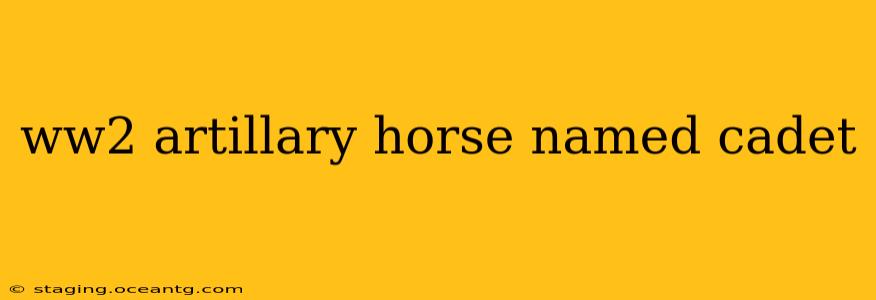The Second World War was a conflict of unprecedented scale, involving not only soldiers and advanced weaponry but also surprisingly, animals. While often overlooked in the historical narrative, animals played crucial roles, from carrying supplies to providing vital communication. One such unsung hero was Cadet, a horse who served with distinction in the artillery during World War II. While specific details about Cadet are scarce – detailed records of individual animal contributions were not always meticulously kept – his story, and the stories of countless others like him, deserves recognition. This article will explore what we can ascertain about horses like Cadet in WWII artillery units, addressing common questions surrounding their roles and experiences.
What was the role of horses in WWII artillery?
Horses in WWII artillery units played a vital role, especially in the early stages of the war and in theaters where terrain was unsuitable for mechanized transport. They were used primarily for:
- Dragging artillery pieces: Heavy artillery guns were cumbersome and difficult to move, especially across rough terrain. Horses provided the necessary muscle power to tow these weapons into position, a crucial task for effective artillery fire.
- Transporting ammunition and supplies: Ammunition and other supplies were often transported by horse-drawn wagons, ensuring a steady flow of materials to the front lines. This was particularly important in areas with limited road access.
- Carrying personnel: In some situations, horses were used to transport personnel, especially in areas where vehicles were impractical. This included carrying wounded soldiers or officers needing quick transport.
- Providing communication: Though not as common as the above roles, horses could sometimes be used to carry messages between units, especially in situations where radio communication was unavailable or unreliable.
Were horses used throughout the entire war?
While horses were crucial in the early years of WWII, their role diminished as the war progressed and mechanized warfare became more prevalent. The increased use of trucks and other motorized vehicles gradually replaced horses in many artillery units. However, even towards the end of the war, horses remained essential in some theaters where the terrain or logistical challenges made mechanized transport difficult or impossible. Cadet, therefore, likely served in a unit where horses were still a vital component of operations, likely early in the war or in a specific theater.
What were the conditions like for horses serving in artillery?
The conditions faced by horses serving in WWII artillery were often harsh. They endured long hours of work, poor weather conditions, and the constant threat of enemy fire. Food and veterinary care were often limited, depending on the logistical situation of their units. The stress and strain of combat took a toll on their health and well-being. Many suffered injuries and illness, and sadly, many perished in the line of duty.
How many horses served in WWII artillery?
Precise figures on the total number of horses that served in WWII artillery are difficult to obtain due to a lack of comprehensive records across different armies. However, it's undeniable that tens of thousands, if not hundreds of thousands, of horses served in various roles throughout the conflict across all participating nations.
What happened to Cadet after the war?
Unfortunately, detailed information about Cadet's individual fate after the war is missing from readily available historical sources. However, his story serves as a representative example of the untold contributions of thousands of animals who served courageously alongside human soldiers during World War II. Their sacrifices and dedication deserve to be remembered and acknowledged.
The lack of detailed information about Cadet highlights the need for further research into the animal contributions during WWII. Preserving these stories is crucial to gain a more complete understanding of the war's impact and the unwavering support provided by these often-unsung heroes. Future research might uncover more information about specific horses like Cadet, allowing us to tell their complete stories.
